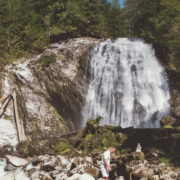Fulfilling a Need for Creamy Goat Cheese at Salt Spring Island Cheese

We left Ganges in a four-seater, red convertible. The top was down. The sun was shining. A tourist map was clutched in my hands.
Our threesome – Colleen Eastman, Danny Levin and I – had a deep-seated need for the creamy goodness known as goat cheese. We were headed to Salt Spring Island Cheese.
The car was a loner, compliments of Roberta Martell, the Sustainability Director at Harbour House, a hotel and working farm on the island.
Less than an hour earlier, she and her trusty four-legged sidekick, Rocky, picked us up just past the gates of Ganges Harbour. Now we were winding our way out of town. It didn’t take long.
The droplet of island we were calling home for the day was just 74 square miles. Thriving on tourism and agriculture, the countryside was largely undeveloped. Bushes grew boldly beside the road. They blocked many a street sign. We saw small homes graced by dirt driveways and pastures filled with goats. There were country gardens, country drivers, and a long-since-forgotten tractor beside a barn. We passed an old stone church overlooking Swartz Bay and nearly passed the small sign to the creamery.
The one-lane farm road suggested we might have been better off borrowing a pickup truck. Its bumpy terrain cut through a lush field of grass and beneath a cool canopy of trees.
From the base of the parking lot we could make out the wood buildings of the creamery.
The shingled sides and slanted roofs were adorned by ivy. It framed the doorways and windows. Near the back of the buildings, a lace curtain billowed out of a second story doorway as though it had been plucked from a French cottage.
Or perhaps it was from Scotland. The curtain marked the residence of David Wood, the creamery’s owner and a former Scott.
Wood sold his first cheese in 1996. The sale marked the six-year culmination of trial and error on the farm and in the kitchen. In those days, Salt Spring Island Cheese raised and milked its own goats. Nearly 20 years later, producing enough milk to keep up with the demand was no longer practical. “These goats are just for show,” Wood said as he walked us through the grounds.
Obviously, the small farm had been outfitted for visitors. A covered wooden pathway ran between the stables and creamery. Large viewing windows offered a real-time look at the making and packaging process. “Just like when we started, everything is handmade right here. We still use traditional methods and we still use high-quality ingredients,” said Wood.
Goat’s milk is inherently smoother than milk taken from its more widely popular sister, the cow. This is because the fat particles in goat’s milk are much smaller. But the real key to a creamy chèvre is the concentration of fat. “You have to really squeeze out the water,” explained Wood.
The smooth texture for which Salt Spring Island Cheese has become well known is only part of what makes this cheese so exceptional. It’s the luscious, almost sweet flavor that has garnered it international attention. Unlike many of the other goat cheese brands, Salt Spring’s chèvres lack the overwhelming tangy finish that can leave your mouth feeling dry and puckered. Wood attributes this to the creamery’s pasteurization process.
Using the “low and slow method,” as Wood calls it, the milk is heated at 145 degrees Fahrenheit for 30 minutes. “You can also do it at 172 degrees Fahrenheit for 18 seconds. The process is a lot faster, which many big cheese producers like. But the low and slow method causes less damage to the milk’s fat,” said Wood. It’s damaging the fat that brings out that strong tang.
The farm’s shop, a long, low-ceilinged room, is flanked by a nearly equally long cheese counter. Available for tasting are free samples of the creamery’s entire line of goat-based cheeses. While the base of each is simple – goat milk, sea salt, dairy culture, and rennet – the beautiful molds tell a more varied story.
You’ll find they’re infused with everything from basil to chilis. There is a Flower Chèvere, Garlic Chèvere and Lemon Chèvere. They use olives, truffles, and peppercorns. The most popular of all is their Ruckles. It features small logs of goat cheese marinated in grape seed oil, fresh herbs, and garlic.
Though best known for their chèvres, the creamery also make fetas, surface-ripened cheeses, and a hard cheese. I found the Blue Juliette, a surface-ripened blue that pairs nicely with red wine, to be particularly delightful.
Our motley crew was leaving with several containers to take home, but we couldn’t help ourselves. We had to try a scoop, okay two, of the creamery’s goat cheese ice cream. Smooth like custard, it was the perfect treat to enjoy on the patio.














